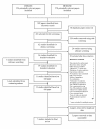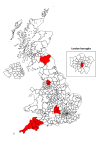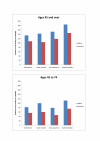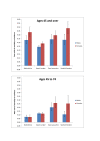The incidence of all stroke and stroke subtype in the United Kingdom, 1985 to 2008: a systematic review
- PMID: 20825664
- PMCID: PMC2944372
- DOI: 10.1186/1471-2458-10-539
The incidence of all stroke and stroke subtype in the United Kingdom, 1985 to 2008: a systematic review
Abstract
Background: There is considerable geographic variation in stroke mortality around the United Kingdom (UK). Whether this is due to geographical differences in incidence or case-fatality is unclear. We conducted a systematic review of high-quality studies documenting the incidence of any stroke and stroke subtypes, between 1985 and 2008 in the UK. We aimed to study geographic and temporal trends in relation to equivalent mortality trends.
Methods: MEDLINE and EMBASE were searched, reference lists inspected and authors of included papers were contacted. All rates were standardised to the European Standard Population for those over 45, and between 45 and 74 years. Stroke mortality rates for the included areas were then calculated to produce rate ratios of stroke mortality to incidence for each location.
Results: Five papers were included in this review. Geographic variation was narrow but incidence appeared to largely mirror mortality rates for all stroke. For men over 45, incidence (and confidence intervals) per 100,000 ranged from 124 (109-141) in South London, to 185 (164-208) in Scotland. For men, premature (45-74 years) stroke incidence per 100,000 ranged from 79 (67-94) in the North West, to 112 (95-132) in Scotland. Stroke subtype data was more geographically restricted, but did suggest there is no sizeable variation in incidence by subtype around the country. Only one paper, based in South London, had data on temporal trends. This showed that there has been a decline in stroke incidence since the mid 1990 s. This could not be compared to any other locations in this review.
Conclusions: Geographic variations in stroke incidence appear to mirror variations in mortality rates. This suggests policies to reduce inequalities in stroke mortality should be directed at risk factor profiles rather than treatment after a first incident event. More high quality stroke incidence data from around the UK are needed before this can be confirmed.
Figures
Similar articles
-
Variations in stroke incidence and survival in 3 areas of Europe. European Registries of Stroke (EROS) Collaboration.Stroke. 2000 Sep;31(9):2074-9. doi: 10.1161/01.str.31.9.2074. Stroke. 2000. PMID: 10978032
-
Global stroke statistics.Int J Stroke. 2017 Jan;12(1):13-32. doi: 10.1177/1747493016676285. Epub 2016 Oct 28. Int J Stroke. 2017. PMID: 27794138 Review.
-
Legg-Calvé-Perthes disease in the UK: geographic and temporal trends in incidence reflecting differences in degree of deprivation in childhood.Arthritis Rheum. 2012 May;64(5):1673-9. doi: 10.1002/art.34316. Arthritis Rheum. 2012. PMID: 22143958
-
Declining trends in incidence, case-fatality and mortality of stroke in three geographic areas of Finland during 1983-1989. Results from the FINMONICA stroke register.J Clin Epidemiol. 1994 Nov;47(11):1259-69. doi: 10.1016/0895-4356(94)90131-7. J Clin Epidemiol. 1994. PMID: 7722562
-
Trends in the epidemiology of cardiovascular disease in the UK.Heart. 2016 Dec 15;102(24):1945-1952. doi: 10.1136/heartjnl-2016-309573. Epub 2016 Aug 22. Heart. 2016. PMID: 27550425 Free PMC article. Review.
Cited by
-
What causes the burden of stroke in Scotland? A comparative risk assessment approach linking the Scottish Health Survey to administrative health data.PLoS One. 2019 Jul 8;14(7):e0216350. doi: 10.1371/journal.pone.0216350. eCollection 2019. PLoS One. 2019. PMID: 31283778 Free PMC article.
-
Risk of Cerebrovascular Diseases After Uvulopalatopharyngoplasty in Patients With Obstructive Sleep Apnea: A Nationwide Cohort Study.Medicine (Baltimore). 2015 Oct;94(41):e1791. doi: 10.1097/MD.0000000000001791. Medicine (Baltimore). 2015. PMID: 26469923 Free PMC article.
-
The Use of Enteral Nutrition in the Management of Stroke.Nutrients. 2016 Dec 20;8(12):827. doi: 10.3390/nu8120827. Nutrients. 2016. PMID: 27999383 Free PMC article. Review.
-
Statin use and high-dose statin use after ischemic stroke in the UK: a retrospective cohort study.Clin Epidemiol. 2019 Jun 28;11:495-508. doi: 10.2147/CLEP.S201983. eCollection 2019. Clin Epidemiol. 2019. PMID: 31388316 Free PMC article.
-
Elevated Plasma Level of Soluble Form of RAGE in Ischemic Stroke Patients with Dementia.Neuromolecular Med. 2017 Dec;19(4):579-583. doi: 10.1007/s12017-017-8471-9. Epub 2017 Nov 2. Neuromolecular Med. 2017. PMID: 29098526 Free PMC article.
References
-
- Scarborough P, Peto V, Bhatnagar P, Kaur A, Leal J, Luengo-Fernandez R, Gray A, Rayner M, S A. Stroke statistics. 2009. British Heart Foundation & The Stroke Association; 2009.
-
- National Audit Office. Health Focus Spring. National Audit Office; 2009.
-
- Capewell S, Allender S, Critchley J, Lloyd-Williams F, O'Flaherty M, Rayner M, Scarborough P. Modelling the UK burden of cardiovascular disease to 2020. London: British Heart Foundation; 2008.
-
- Sudlow CLM, Warlow CP. Comparing stroke incidence worldwide: what makes studies comparable? Stroke. 1996;27:550–8. - PubMed
Publication types
MeSH terms
Grants and funding
LinkOut - more resources
Full Text Sources
Medical





